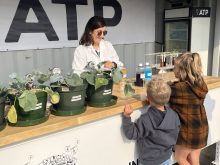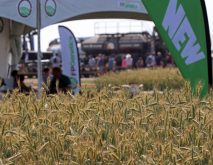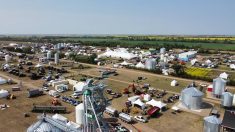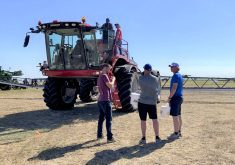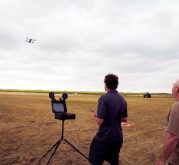There are about 1,500 people living in Langham, Sask., near Saskatoon. But for three days every summer, the area’s population balloons to the size of a small city.
It’s been 10 years since farmers and agribusinesses first started streaming to Ag in Motion. Today, it’s the largest outdoor farm show on the Prairies, drawing a record 31,166 visitors last year. It’s become known for its equipment and product demonstrations, crop research highlights, wide range of exhibitors and networking events.
The trade show alone takes up 100 acres of the event’s 610-acre host site, Glacier FarmMedia’s Discovery Farm Langham. There are about 60 acres of parking, 70 acres of demonstration space and large areas to highlight crop plots.
Read Also

Seeding Indigenous agricultural prosperity
National Circle for Indigenous Agriculture and Food says Indigenous agricultural success needs strong relationships.
Why it matters: Ag in Motion runs from July 16-18 this year.
Building the show into the event it is today has taken years of planning.
“I felt like this was a once in a lifetime opportunity, to start something from scratch. It was very attractive to do that,” said Rob O’Connor, the show’s director since its inception.
O’Connor wasn’t new to farm shows when he started with AIM. He previously worked with the Regina Exhibition Association and acted as manager for Canada’s Farm Progress Show. He was working at the Provincial Exhibition of Manitoba in Brandon when the chance came to join the AIM team.
“It was easy for me to make that switch, even though I did really enjoy what I was doing in Brandon,” he said.
History of AIM
Glacier FarmMedia already owned Canada’s Outdoor Farm Show in Woodstock, Ont., when it launched AIM. The company bought the Ontario show in 2012 and ran it with the intent of learning how a large outdoor trade show operated. Managers wanted to know if they could create a similar event in Western Canada.
“We kind of looked at whether the show was viable, and we felt it was,” O’Connor said.
Aside from him, the first planning team included staff from the Woodstock show and others based in both Manitoba and Alberta.
The first show involved a bit of scrambling. First, they had to find a home for the event. The team considered locations across the Prairies before homing in on the area around Saskatoon. The search ended at the property near Langham, attractive because it was close to a major city and a major highway.
On the downside, the site needed a lot of work. It hadn’t been an active farm. About 100 acres of grass had to be planted and grid roads built before it looked ready to host a premiere agricultural event.
“We wanted to show people we’re putting our roots in this property and investing in it,” O’Connor said.
In January 2014, the team was ready to announce the new show and decided it would run the third Tuesday to Thursday of July.
Early AIM supporters included the Saskatchewan government, the University of Saskatchewan and dozens of companies who committed to participate before the show even launched. From January to June, another 120 companies joined the roster.
“The last six weeks before the show, we had a pretty good blitz and we ended up attracting about 50 more companies. In the end, we had about 200 companies at our very first show,” said O’Connor.
It was marketed through Glacier FarmMedia publications as well as through a promotional radio program. That first event attracted 11,000 people, mostly from the Prairies, although a few attendees came from the United States, British Columbia and Ontario.
Last year, show attendees filled up hotels in Saskatoon and the city of Warman. People also stayed in hotels in the Battlefords, about a 45-minute drive from Saskatoon.
“To have that kind of impact on tourism for that part of the province is important to us.”
AIM draws
The show has been successful partly because it is framed as an agricultural production trade show, said O’Connor.
“It’s really business-to-business. It’s not a business-to-consumer show, because we recognize farms as a business, and I think that’s unique.”
The demonstrations program, a major hit of the show, has expanded significantly since 2014. Today, up to 20 companies might be in attendance to demonstrate equipment. The lineup has included everything from a seeder to a rock picker to a truck.
“That first year, we gave people a taste of what we were going to do,” O’Connor said. “We tried to get some companies to do some demonstrations. One thing that’s been a big benefit to the show is, not only do we have those demonstrations where three to five companies can demonstrate something like air seeders or tillage equipment (at one time), but we also give companies the opportunity to have space at the show so they can demonstrate their own product.”
To better represent agriculture in Western Canada, AIM also includes livestock equipment. Livestock and forage-oriented businesses make up about a quarter of exhibitors. That has resulted in more livestock equipment demonstrations and knowledge sessions geared to ranchers.
Ag tech programming has also expanded.
“Those innovators, those ag tech companies and associations, they can test their ideas with the farmer base to find out if they’re going down the right path and if (those ideas are) actually going to be a solution to some of the problems producers have in agriculture,” O’Connor said.
Show topics change every year.
“It has a lot to do with what the industry is doing now and what we think the industry is going to do in the future.”
AIM challenges
There have been speed bumps in the last decade. In particular, the show had to contend with lockdowns and public health requirements during the COVID-19 pandemic.
“We as a company had to decide what we wanted to do,” O’Connor said. “We are a show that spans more than just Saskatchewan and Saskatoon. We needed to recognize that the pandemic, being that it was across the country, would have brought a lot of people together from outside of just one local area.
“We couldn’t do the show, even though during both summers in Saskatchewan, technically, you could do an outdoor event. We didn’t want to become one of those super spreader events.”
AIM’s solution was to go online. In 2020, a five-day digital Ag in Motion was built. The digital show included seminars and product launches. There were over 200 exhibitors and about 9,000 attendees.
By 2021, people were starting to experience digital fatigue. To meet that new challenge, AIM opted for six half-day events throughout the season, which attracted about 1,200 attendees.
Since the pandemic, the show is back in person and still trying to improve.
“What we’re doing is we’re trying to theme more areas of the show to help with people’s experiences at the show,” O’Connor said. “For instance, most of the livestock programming and livestock exhibitors are in one area of the show. The irrigation part of agriculture is basically in one area of the show.
“The companies that have drone technology and that kind of data collection, they’re in one area of the show. All the ag tech is in one area, and international is all in one area.
“As the show continues to grow, you’ll see more and more areas being themed, so farmers have a better experience. They don’t have to travel the entire show if they’re trying to compare products or want to listen to similar presentations.”
AIM 2024
About 30 companies put in crop plots this year to demonstrate genetics or crop inputs. Other plots, managed by the Discovery Farm, are for larger research projects.
As the show grows, events are also moving into Saskatoon. The Field of Stars event, which premiered in 2023, was set up at Prairieland Park, and will be held there again this year. The innovations in ag reception has also been held in Saskatoon on the night prior to the show for the last several years.
This year, innovations will be showcased through an awards program held at Saskatchewan Polytechnic, in partnership with the Agricultural Manufacturers of Canada. The Saskatchewan Trade and Export Partnership will hold an international reception at Saskatoon’s Remai Modern Art Gallery.
“We’re starting to see the impact of the show move into the city in the evenings,” said O’Connor.
This year’s event will feature a new Indigenous program created in conjunction with Farm Credit Canada.
O’Connor said the goal for the future is to attract more interest from more international companies.
“We have a really strong international business program committee that is going to help provide advice to us as show management to help us get to that next step for that market.”
More information on this year show can be found on the AIM website at https://aginmotion.ca. Coverage leading up to the site can also be found at https://www.producer.com/content/ag-in-motion/.



